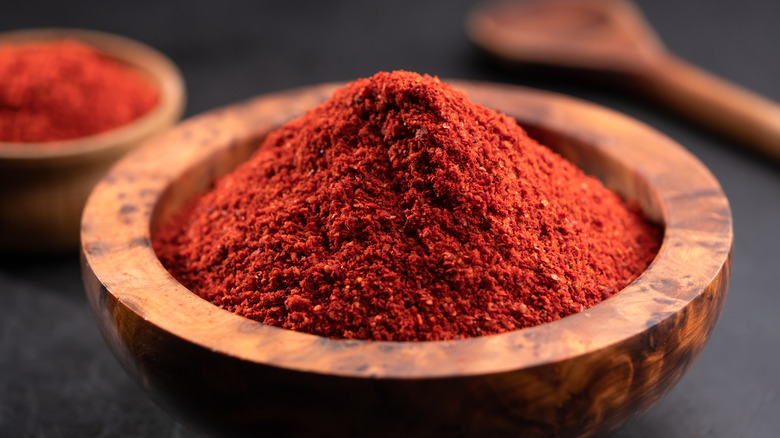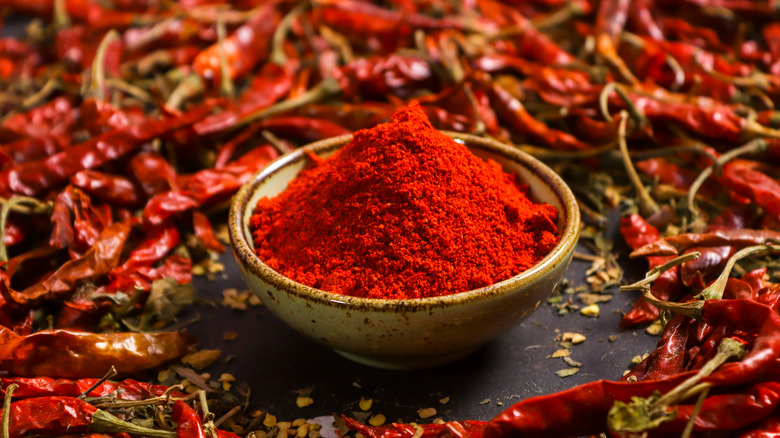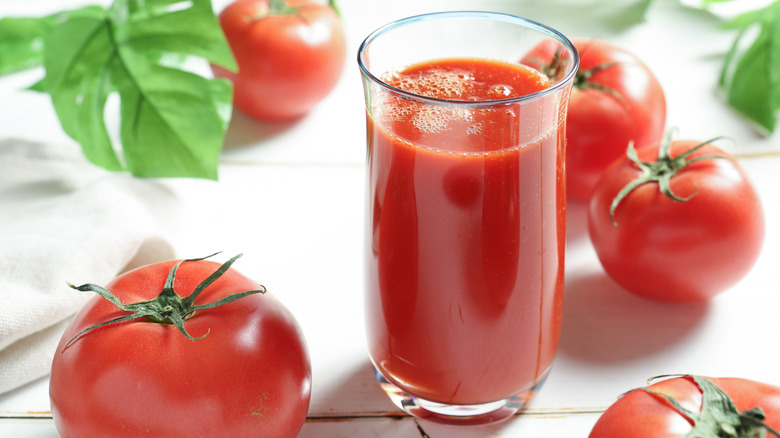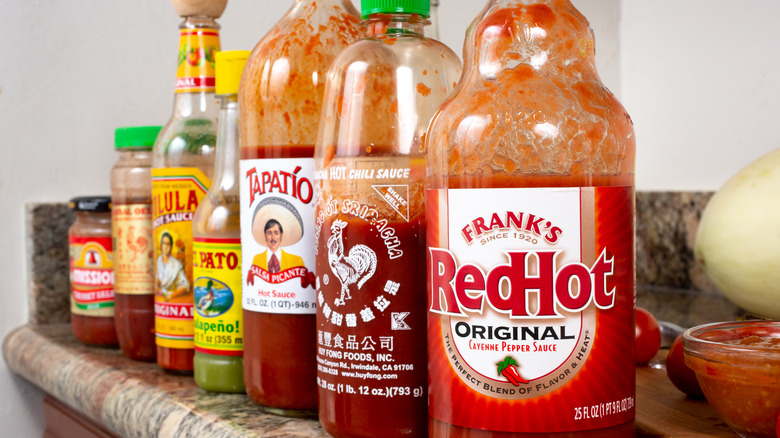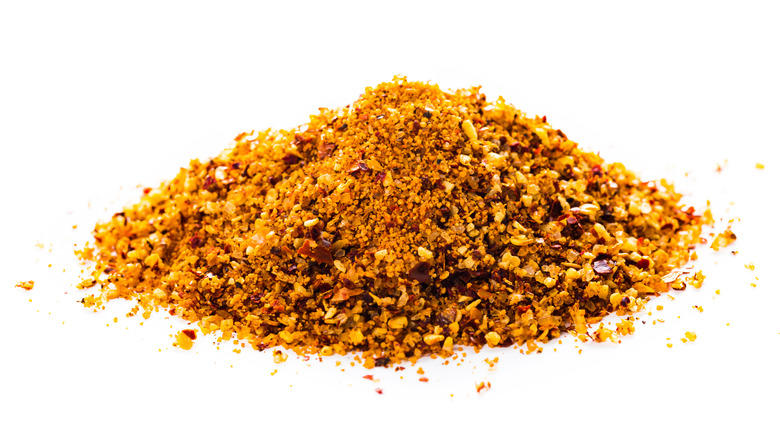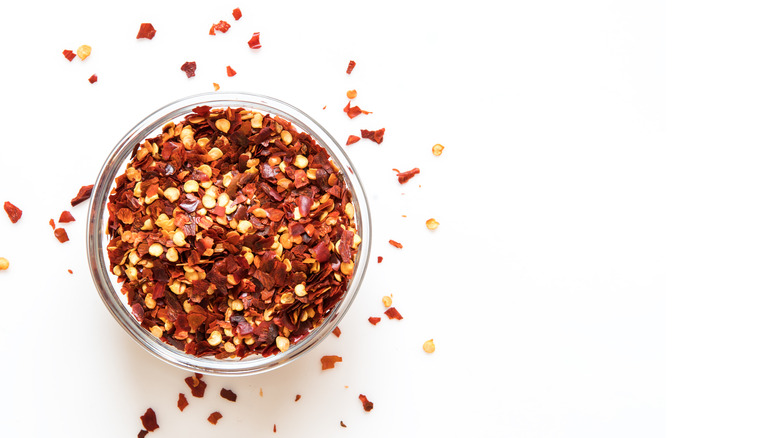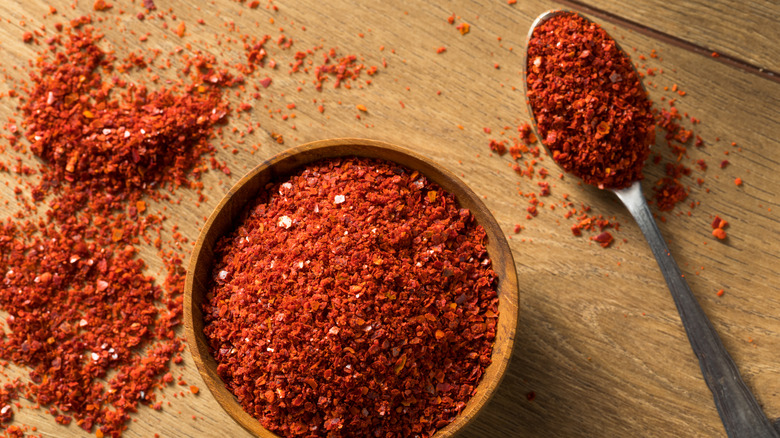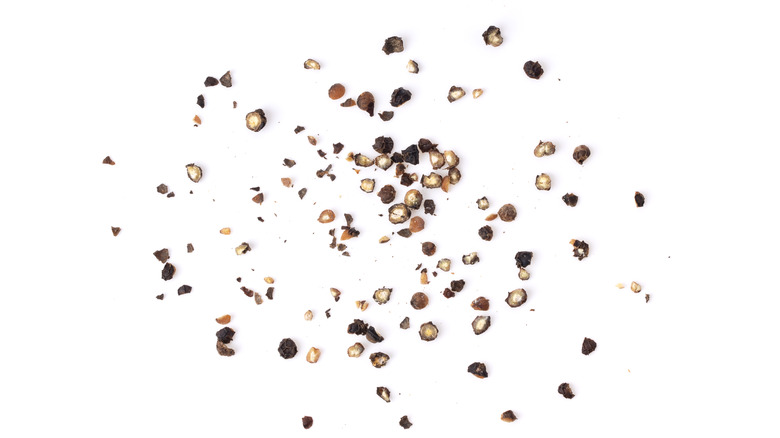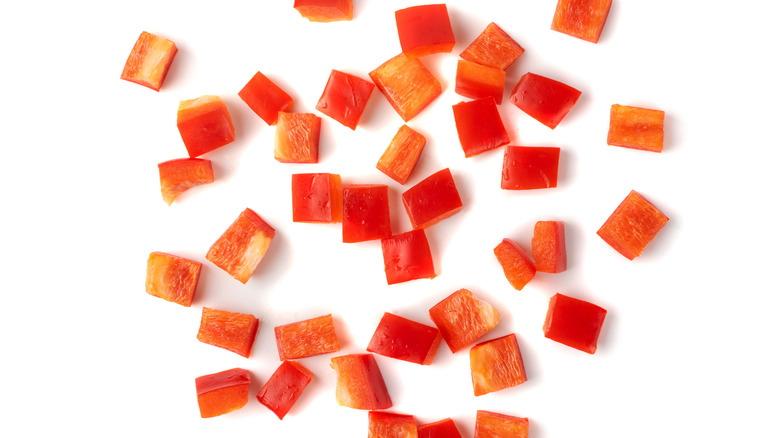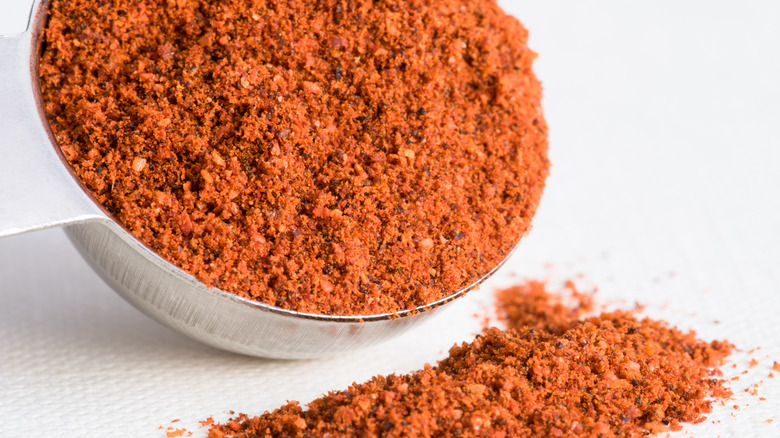10 Best Substitutes For Sweet Paprika
No kitchen spice cabinet is complete without paprika. Even if you don't use this crimson-colored powder often (though you should!), it always seems to be lurking on the shelf.
True paprika comes from a number of specific pepper types grown exclusively in Spain and Hungary and is even the national spice of Hungary (via Pepper Scale). There, among other countries, the pepper pods are dried and then ground into the fine powder you see in the spice jar or bottle.
While only certain families of peppers are used to make paprika, there are three different variations on the market: sweet, smoked, and hot (via Cooking Light). It's also worth noting that you can tell if paprika is hot or sweet based on the color (via Taste Essence). Orange paprika is among the hottest paprika colors, while dark red paprika is the sweetest variety.
Sweet paprika is most often simply labeled as paprika, and it works best for garnishing dishes like deviled eggs. This type of paprika does not pack any heat, so it's a great go-to for most dishes (via Cooking Light). Add it into dishes for the pop of color and a mildly smokey, earthy depth of flavor. But if you don't have sweet paprika on hand, here are some of the best substitutes for it.
1. Chili Powder
According to Taste Essence, chili powder is among the best paprika substitutes because it has one of the most similar colors and flavors to paprika. Made in the same way as paprika, chili powder tends to be made from cayenne peppers or red peppers, but this pepper powder lacks the same signature heat as cayenne pepper. The dark red color is quite close to that of paprika which will liven up many dishes along with its low heat and mildly sweet, smokey flavor.
That's why you can use chili powder in equal parts to paprika in most recipes. Any savory recipes that call for paprika can be made with chili powder thanks to its mild and earthy flavor. Consider it for marinades, soups, stews, roasts, vegetables and so much more. Chili powder is undoubtedly one of the easiest substitutes for paprika thanks to its abundance as a pantry staple and its ability to be used in equal parts to paprika.
2. Tomato Juice
For recipes that can use a liquid ingredient as opposed to a powder, tomato juice is an option to replace sweet paprika (via Taste Essence). While tomato juice won't add quite the same vibrant red color and certainly doesn't have the same mild smokey flavor, it is a sweeter option for those who dislike other spicy pepper powder alternatives. If you do want to add slightly more heat or smokiness, you can always sprinkle a bit of chili powder or cayenne pepper into the dish too.
When using tomato juice, you can substitute it for both the paprika and the water or stock that the recipe calls for, according to Taste Essence. That's why this alternative is best for dishes like soups, stews, braises, and more. If you'd prefer to pack more flavor or need to cut down on the liquid, you might consider using tomato paste, too, instead of tomato juice. You'll still need to sprinkle in a touch of pepper for additional smokey flavor, but it's another option to consider.
3. Cayenne Pepper
Cayenne pepper can be used as an alternative to sweet paprika. If you are not a fan of heat, it might actually surprise you that cayenne pepper is one of the best options because the heat can be toned down. Cayenne pepper will add the same vivid color to dishes, but to tone down the heat, you'll want to use less of it. If you really don't want any heat in the dish or you need a subtle flavor, you can add a touch of sugar to get a closer flavor to sweet paprika (via Raw Spice Bar).
Cayenne pepper can be used in a wide variety of dishes ranging from sweet and spicy to savory. Consider using it in sweet and spicy desserts, in marinades, on vegetables, in casseroles and so much more. For dishes that can take the heat, use half a teaspoon of cayenne pepper per one teaspoon of sweet paprika. Try adding in half a teaspoon of sugar for dishes that need a milder flavor.
4. Hot Sauce
If you run out of paprika and also happen to be a huge hot sauce fan, you'll be glad to know that you can use it as a substitute (via Taste Essence). Hot sauce as well as other chili sauces offer a similar smokey, sweet, and slight heat as paprika to dishes. Though you'll also get a tang from the vinegar in the hot sauce, it's still a suitable option for many dishes.
Hot sauce will work well in many recipes such as marinades, rubs, soups, stews, roasts, braises, and more. You can top off recipes with a touch of hot sauce for the same flavor and a dash of color or you can incorporate it earlier into the dish to have the flavor cooked into the dish to meld with the other prominent ingredients. Start by adding a few shakes and taste-test the recipe as you go until you are happy with the flavor. You can always add more, but you cannot take it out once it's been added in. So, use caution to flavor the dish with hot sauce.
5. Aleppo Pepper Powder
Cooking Chew also suggests using Aleppo pepper powder. Aleppo powder is also made by drying and grinding up red Aleppo peppers, so you'll still get a similar color and flavor from the sweet paprika alternative. According to Cooking Chew, Aleppo peppers fall between cayenne peppers and paprika in terms of spiciness. So you don't have to worry about the level of heat Aleppo powder will add to a dish.
Because Aleppo powder is somewhat hotter than typical sweet paprika, you'll want to use half the amount that the recipe calls for. So if you need one tablespoon of paprika, you should substitute it for half a tablespoon of Aleppo pepper. Because this easy substitute is so close to the original ingredient, it means you can use Aleppo pepper powder in all of the recipes and dishes you love that call for sweet paprika. If you don't have it on hand already, add it to your grocery list so you can add it to your backstock the next time you shop.
6. Red Chili Flakes
Red chili flakes are another dried pepper alternative to paprika. However, they obviously have a coarser, chunkier texture than that of finely ground paprika or other pepper powders (via Cooking Chew). Apart from the larger pieces and different textures, red chili flakes will provide a very close color and flavor to paprika.
If you do opt to use red chili flakes, use just one-quarter of what the recipes call for in paprika. This will help you achieve the flavor you want without added heat.
It's also worth noting that you can always pop your red chili flakes into the food processor along with the other ingredients to make a smooth mixture if you're whipping up something like a sauce or hummus. Otherwise, just sprinkle in the flakes and you'll hardly notice the seeds and flakes in your dishes. From marinades and dry rubs to soups and casseroles, you can use this alternative for most savory recipes.
7. Maras Pepper Flakes
Maras pepper flakes are another type of pepper flakes that you can substitute for paprika. Though this Middle Eastern spice might not be as prevalent in the supermarket, it is among the best alternatives to paprika (via Raw Spice Bar). That's because maras pepper flakes have a very similar sweet flavor with a touch of heat too. Even though the texture is obviously different from a powder, it can still be easily managed in most dishes.
Because maras pepper flakes have slightly more heat than sweet paprika does, Raw Spice Bar suggests using half a teaspoon of maras pepper flake to one teaspoon of paprika. If you're comfortable with heat and like a little spiciness, you can always add more.
Just like red pepper flake, maras pepper flakes can be added to the food processor to blend your dish until it is a smooth homogenous mixture if you're making sauces, hummus, or other dips. Otherwise, the pepper flake substitute will simply have a more textured presence.
8. Crushed Black Peppercorns
Freshly cracked black peppercorns can also make a great alternative to sweet paprika (via Raw Spice Bar). Black peppercorns will add a hint of heat and a bit of smoky flavor to most dishes, though it won't add the same dash of color that paprika would. This substitute is best when the flavor is key and you really want to layer some flavor into your dish, black peppercorns are better than nothing (via Taste Essence).
If you don't have a pepper mill or it's broken, you can simply pour whole black peppercorns into a plastic bag and use a rolling pin to crush them for your dish. Remember to use equal parts black peppercorns to paprika, too.
Black pepper will work for most dishes, but Raw Spice Bar advises avoiding it for tomato-based recipes such as sauces, soups, and more. If you really love black pepper, you might not mind the combination, though.
9. Bell Pepper
If all you have on hand are fresh peppers, such as bell peppers, then you're still in luck. You can actually make your own paprika powder out of them. This will provide you with a near-perfect substitute, considering the mildly sweet and smoky flavor will be spot-on. If you have red bell pepper, then the color will be just right too. Otherwise, green, yellow, or even orange bell peppers will still add a pop of color to the dish.
To accomplish this substitute, use your oven or a dehydrator to dry out the peppers before grinding them into a powder. What you'll end up with is an even fresher, more flavorful paprika alternative. This also means you can use it in equal parts to store-bought paprika in all of the same ways too.
If you don't have the time or don't want to make the effort to make homemade paprika, you can still use bell pepper. Try mincing it and cooking it down a bit before adding it to your dish. Just know that the flavor will be fresher and crisper than a powdered version. Use this option in soups, stews, braises, and roasts.
10. Chipotle Powder
Finally, chipotle powder is quite similar to substituting chili powder or cayenne pepper powder for sweet paprika. Chipotle powder is also made by drying and grinding the chipotle peppers and provides a hint of color to dishes (via Taste Essence). The only downside is that, like chili powder or cayenne pepper, chipotle pepper packs quite a bit more heat than sweet paprika. It tends to be closer to a spicier paprika powder, but it can still be a pleasant substitute.
Use half the amount of chipotle pepper as you would sweet paprika to minimize the heat. You can also add in a bit of sugar just as you might for cayenne pepper to bring about a better balance of flavors that would be present if you were using sweet paprika. Ultimately, this should give you the mildly sweet and smoky flavor you'd like with just a tiny bit of heat.
